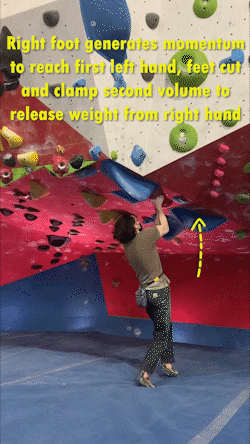Breakdown
Climber: Eddie Pandolfino 6’0”/-2
Wall Angle: Roof > 5° Overhang
Holds: eGrips Hueco Wonder Pockets, Flathold Superstar, Pusher Boss, Cheeta BoomJump 5
RIC: Risk 1, Intensity 4, Complexity 4
This boulder revolves around definitive sequences and body positioning. Intensity is high on this boulder because of the finger strength required for the pockets, the constantly tensioned body positioning, and the overall length of the boulder. Complexity compliments the intensity by having the sequences be intricate. There are many advanced techniques required (feet first, rose move, toe/heel hooks) to complete the boulder. The movements also require nuanced body positioning to complete. Risk is low on this boulder because there are no low percentage movements.
Influence/Aesthetic
The placement and sequence through the pockets were the starting point for this climb. I wanted the climber to perform big, gymnastic, crossing movements to traverse the face of the wall. This is not the most aesthetically pleasing boulder because function was prioritized. However, the contrast of grouping smooth and textured holds throughout the climb creates a loose visual theme. The stack volumes of increasing size at the lip aid in visual effect as well as functionally extend the wall angle.
Hold Choice:
Most of the holds selected for this boulder have the key element of directionality. The pockets are usable by one hand, from one direction, making it intuitive to climb through them with large sweeping hand movements that cover distance. The slopers at the end are arranged in a difficult position to match causing the climber to readjust their body multiple times to gain correct directional positioning to use them.
Kick It
The climber places a high right foot to start. This aids in pushing out towards the first pocket.
Once the first pocket is gained there are no foot options below the climber, causing them to kick their feet leftward to the second volume.
Twist and Turn
Climbers remove weight from their right hand by tensioning their feet, which allows the right hand to cross under to the second pocket.
The climber’s movement becomes slightly restricted because of how close their hands and feet are.
Walking their feet outward helps to reestablish tension on the left hand.
Open Up
The climber’s chest and hips are able to open up now that their feet are farther, letting the left hand unwind and move to the third pocket.
A heel hook is set to keep shifting the climber’s weight leftward.
Two Toes
The climber walks their feet around the corner to set a double toe hook. This creates an anchor point to release weight from the hands and begin pivoting their hips.
Sinking their hips low allows the climber to match the sloper and begin turning their body to face the arete.
Quick Swap
Quickly moving their left hand to the hold around the corner while simultaneously dropping their feet allows the climber to turn their body straight onto the corner.
Setting a heel hook brings the climber’s hips back up and helps maintain tension for a left-hand bump.
Slippery Slopers
The direction of the slopers requires a slightly left-leaning body position.
Bumping to the first sloper with the right hand brings the hips high enough over the lip to set a right heel hook.
Taking the Top
The climber maintains their slightly left-facing body position to bump their right hand to the second sloper.
The left heel hook is reset to center the hips on the arete and prevent weight from coming too far leftward when moving to the finish.
Final Thoughts
There are often certain moves and sequences that need highly specific holds or wall angles to set. I had come up with the idea of setting this sequence a few months ago but did not have the correct resources available. This is because holds are constantly being rotated throughout the gym and in a commercial setting environment it could take months to get holds down from certain routes or boulders. I usually don’t have definitive ideas for my boulders going into the setting day because it helps me be more flexible during the setting and tweaking process. However, cooking up sequences or moves for the future can keep psych high and keep excitement for upcoming sets.







